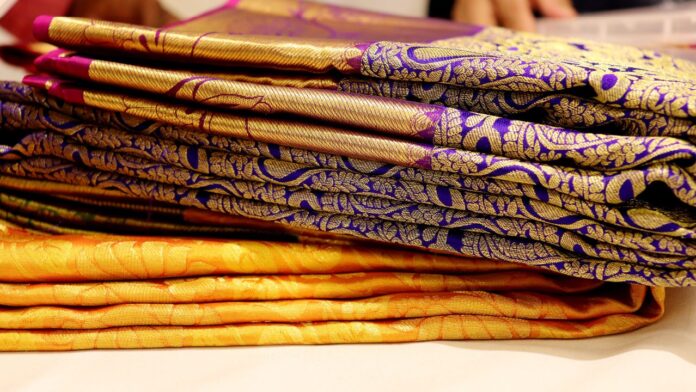India is a land of diverse cultures and traditions, and one of the most unique and beautiful examples of this is the Tussar sarees. The exquisite fabric is known for its rich texture and earthy hues and is deeply ingrained in the cultural heritage of eastern India.
Tussar silk is produced from the cocoons of the Antheraea moth, which is found in the forests of eastern India. The silk is known for its natural golden colour and textured feel, which sets it apart from other types of silk. The fabric is produced using traditional handloom techniques, which add to its unique texture and character.
The making of Tussar silk sarees is a labour-intensive process involving the use of traditional handlooms and intricate weaving techniques. The process begins with extracting the silk from the cocoons, which is done by boiling the cocoons in hot water to loosen the silk fibres. The fibres are then carefully unwound and spun into threads.
Once the threads are ready, the weavers begin setting up the loom. The loom is a complex piece of machinery used to hold the threads together while they are woven together. The weavers carefully thread the loom, ensuring that the threads are evenly spaced and that the tension is just right.
Once the loom is set up, the weavers begin weaving the fabric. This involves carefully passing the shuttle through the threads, weaving in different threads of contrasting colours to create intricate designs. The weavers work slowly and meticulously, ensuring that each thread is in the right place and that the design is perfect.
As the fabric is woven, it is carefully inspected to ensure that it meets the high standards of quality expected of a Tussar saree. Any imperfections or errors are carefully corrected by the weavers, who take great pride in their work and strive for perfection in every piece they create.
The finished Tussar saree is beautiful, with its unique texture and rich, earthy hues. The fabric has a natural sheen that adds to its elegance, and the intricate designs are a testament to the skill and creativity of the weavers.
The Tussar saree has deep cultural significance in eastern India, where it is often worn for special occasions and festivals. The fabric is highly valued for its texture, colour, and beauty and symbolises the region’s rich cultural heritage.
In addition to its cultural significance, the Tussar saree also has important economic and environmental benefits. The production of Tussar silk employs thousands of weavers and artisans in rural areas of eastern India and helps to support local economies. Moreover, the use of natural silk and dyes in the production of Tussar sarees is an eco-friendly alternative to the mass-produced synthetic fabrics that are common in the textile industry.
However, the traditional art of Tussar weaving is under threat in India, as many weavers struggle to make a living from their craft. The rise of machine-made textiles and cheap imitations has led to a decline in demand for traditional handwoven fabrics, and many weavers are forced to turn to other forms of work to make ends meet.
To help preserve this important cultural heritage, many organisations are working to promote and support traditional weaving techniques in India. These organisations provide training and support to weavers, helping them to improve their skills and to market their products to a wider audience.
By supporting traditional artisans and preserving the art of Tussar weaving, we can help to ensure that this beautiful and unique art form continues to thrive in India for generations to come. We can also help to support the livelihoods of skilled weavers, providing them with a source of income and a means of preserving their cultural heritage.
Conclusion
The Tussar sarees are a beautiful and unique example of the rich cultural heritage of eastern India. The process of creating these exquisite fabrics is a labor-intensive journey that involves the use of traditional handloom techniques and intricate weaving methods.
By supporting traditional weavers and preserving the art of Tussar weaving, we can help to ensure that this important cultural heritage is passed down to future generations and that the skilled weavers who create these beautiful fabrics are able to earn a livelihood and support their families.
When we choose to purchase traditional handwoven textiles like Tussar silk sarees online or offline, we help to support sustainable and eco-friendly methods of textile production, while celebrating the beauty and cultural significance of these fabrics.








